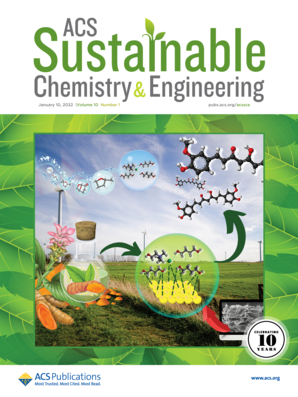Bioinspired Biobased Elastomeric Adhesive Using Diels–Alder Chemistry
IF 7.1
1区 化学
Q1 CHEMISTRY, MULTIDISCIPLINARY
引用次数: 0
Abstract
Inspired by the robust adhesion mechanisms of marine organisms, this study presents the development of catechol-modified, biobased elastomeric adhesives utilizing Diels–Alder (DA) “click” chemistry. Epoxidized natural rubber (ENR), a sustainable elastomer derived from natural rubber, was chemically modified to introduce furfuryl functionality, enabling dynamic cross-linking with a catechol-based cross-linker (DOPAMal: dopamine-maleimide). The resulting adhesive system combines the remarkable adhesion properties of catechol moieties with the thermal reversibility of DA chemistry, creating a unique platform for advanced adhesive applications. The thermo-reversible covalent bonds formed via DA chemistry were characterized using differential scanning calorimetry (DSC) and Fourier-transform infrared (FT-IR) spectroscopy. The incorporation of the catechol-based DOPAMal into the polymer chains transformed the soft ENR into a more rigid material, as demonstrated by nanoindentation (NINT) analysis. The tensile study revealed a notable improvement in mechanical strength due to the formation of hydrogen bonding and dynamic covalent DA adducts. Adhesion strength and reusability were evaluated through lap shear tests, revealing strong bonding and remarkable recovery. The adhesives demonstrated excellent self-healing behavior, as confirmed by optical microscopy, with damage recovery attributed to dynamic covalent bonding and hydrogen bonding interaction. This system utilizes the reversible nature of Diels–Alder reactions in combination with the strong noncovalent interactions of catechol moieties to create adhesives with superior adhesion strength, thermoreversibility, and self-healing properties. These properties make the developed adhesives highly suitable for applications in coatings, biomedical materials, and other industries requiring durable yet reversible adhesive systems. The work establishes a versatile framework for incorporating bioinspired strategies into elastomeric materials, paving the way for sustainable and multifunctional adhesives.采用Diels-Alder化学的仿生生物基弹性粘合剂
受海洋生物强大的粘附机制的启发,本研究提出了利用Diels-Alder (DA)“点击”化学的儿茶酚改性生物基弹性体粘合剂的开发。环氧化天然橡胶(ENR)是一种源自天然橡胶的可持续弹性体,通过化学改性引入糠基功能,可以与基于儿茶酚的交联剂(DOPAMal:多巴胺-马来酰亚胺)动态交联。由此产生的粘合剂系统结合了儿茶酚基团的显著粘附性能和DA化学的热可逆性,为先进的粘合剂应用创造了独特的平台。利用差示扫描量热法(DSC)和傅里叶变换红外光谱(FT-IR)对DA化学形成的热可逆共价键进行了表征。正如纳米压痕(NINT)分析所证明的那样,儿茶酚基多巴胺与聚合物链的结合将软ENR转化为更刚性的材料。拉伸研究表明,由于氢键和动态共价DA加合物的形成,机械强度显著提高。通过搭接剪切试验评价了粘接强度和可重复使用性,表明粘接强度强,恢复效果显著。光学显微镜证实,胶粘剂表现出优异的自愈行为,其损伤恢复归因于动态共价键和氢键相互作用。该系统利用Diels-Alder反应的可逆性质,结合儿茶酚部分的强非共价相互作用,创造出具有优异粘附强度、热可逆性和自愈性能的粘合剂。这些特性使得开发的粘合剂非常适合应用于涂料,生物医学材料和其他需要耐用且可逆的粘合剂系统的行业。这项工作为将生物灵感策略融入弹性材料建立了一个通用框架,为可持续和多功能粘合剂铺平了道路。
本文章由计算机程序翻译,如有差异,请以英文原文为准。
求助全文
约1分钟内获得全文
求助全文
来源期刊

ACS Sustainable Chemistry & Engineering
CHEMISTRY, MULTIDISCIPLINARY-ENGINEERING, CHEMICAL
CiteScore
13.80
自引率
4.80%
发文量
1470
审稿时长
1.7 months
期刊介绍:
ACS Sustainable Chemistry & Engineering is a prestigious weekly peer-reviewed scientific journal published by the American Chemical Society. Dedicated to advancing the principles of green chemistry and green engineering, it covers a wide array of research topics including green chemistry, green engineering, biomass, alternative energy, and life cycle assessment.
The journal welcomes submissions in various formats, including Letters, Articles, Features, and Perspectives (Reviews), that address the challenges of sustainability in the chemical enterprise and contribute to the advancement of sustainable practices. Join us in shaping the future of sustainable chemistry and engineering.
 求助内容:
求助内容: 应助结果提醒方式:
应助结果提醒方式:


